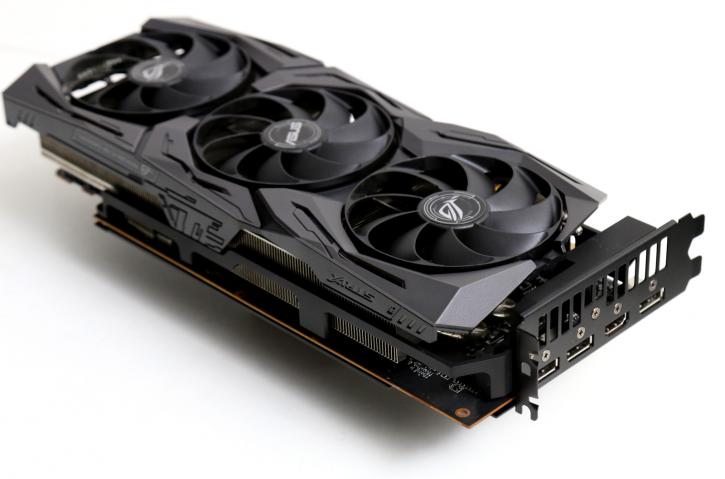Final words and conclusion
.final words
There's no denying it, ASUS brings the 5700 series to a realm where it needs to be, silent and good looking. The card performance really is reference in terms of numbers with an up-to 1% deviation, and with the advertised clocks (1725 MHz game clock) that makes sense of course. The card however utterly odomizes the reference blower-style cooler from AMD. That one is rated at 45 DBA, this STRIX in it's loudest performance mode runs 11 DBa more silent in that 34 DBa range, and that my friends is what we call a staggering differential. But given the size and weight of the cooler armed with three fans, it isn't a surprise either. Compared to reference, depending on how and where you measure you gain an extra 1 maybe 2% with the latest drivers. Tweaked you can create an offset in your advantage of roughly 4%, which is the new norm for AMD it seems whereas NVIDIA upholds a 10% tweaking margin. The realm AMD is sitting in performance-wise with the RX 5700 series is the non-Super models 2060 and 2070 with exceptions here and there. Then there is, of course, the discussion on how relevant you find hardware-accelerated Raytracing and Tensor support. Most of you don't care at this time, but much like anything in the tech industry, everything will evolve, and AMD positioned itself to be smacked down in the middle of that next step in the gaming evolution. By not offering at least RT support, their trump card really needs to be pricing and proper shader-based gaming performance.
.performance
XT or non-XT, both Radeon RX 5700 cards show good, in fact, super strength at Quad HD resolutions in that 2560x1440 realm of resolutions. Games like Battlefield V will make you aim, shoot and smile. As always comparing apples and oranges, the performance results vary here and there as each architecture offers advantages and disadvantaged in certain game render workloads. Battlefield V and Metro: Exodus skyrockets for NAVI. So you'll be seeing wins and losses in perf compared to team green. AMD has got the right amount of graphics memory applied, the right type this time as well as 8GB GDDR6 graphics memory running over that 256-bit bus at 14 Gbps, is done right. The new architecture does show strength and IPC increase, especially seen from Polaris the results are pretty amazing. However, that statement has no merit, as they are not priced in the same region. Realistically the XT card makes good sense in the Wide Quad HD space (monitor resolution of 2560x1440) and can even properly handle games at 3840x2160 (Ultra HD). Result vary per game title though.
.pricing
The 5700 STRIX remains somewhat on the high side of the pricing, but at an expected 449 USD / 475 EUR you receive a custom product with one of the better coolers we've tested to date when it comes to looks and acoustics. However, the conundrum for ASUS is simple, an XT version sits at the same price level and in the end, my best guess is that people will go for the XT just based on performance. We also need to weigh in another factor, it is the MSRP, and if the volume availability is low, etailers will drive up prices based on demand to make a quick buck. But we'll have to wait and see how that pans out.
.cooling & noise levels
Cooling is a choice with the STRIX, silent mode sits at roughly 65 while gaming, and that is fine. Honestly, we advise the performance BIOS mode and let things be as they are as this thing is just very silent. We've have not heard noticeable coil whine. But I do want to note that any graphics card at a high-enough FPS will make some coil-whine.
.energy
The TDP for this XT we measure to be roughly 180 Watts, it's a little higher than reference but that number varies a bit per game title, workload, resolution and even refresh rate of course. It's a normal wattage for this product.
.conclusion
Much like the XT model, ASUS offers a terrific product here with that ginormous and capable cooler and dark visuals. It's silent at a level I like to call extreme, and that goes for both the performance and silent BIOS mode. It cools great and offers performance and tweaking levels on the GPU that are at a normalized reference level. NAVI cards behave extremely well in a 2560x1440 range of resolutions, but with some titles, perf can cave in where in others it takes a lead. Whether or not this performance is justified at the recommended retail prices, I don't know and we'll have to wait and see how that pans out. GDDR6 then, the card comes with a proper 8GB of GDDR6 memory. Really, that exactly right and what these products it needs. The 5700 STRIXs biggest problems might become the price tag, the non-XT model overall is 10% slower but that reference XT product starts at 399 USD. ASUS just confirmed the pricing to be 449 USD / 475 EUR, and that is a hefty price premium for a 5700 non XT card. From a hardware point of view though, the card ticks most if not all of the right boxes. The card overall will easily deserve our recommended award, with the right price, it would have been a top pick easily.
- Unigine Heaven Stress test
- MSI AfterBurner
- 3DMark FireStrike + Time Spy + Port Royale)
- Download AMD Radeon drivers
- Download NVIDIA GeForce drivers
Sign up to receive a notification when we publish a new article.
Or go back to Guru3D's front page



